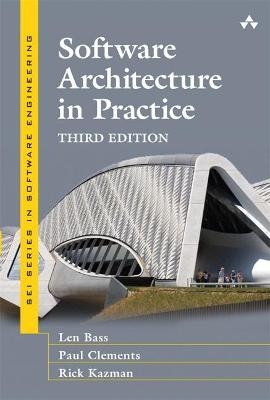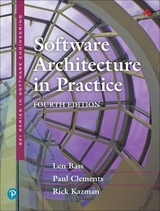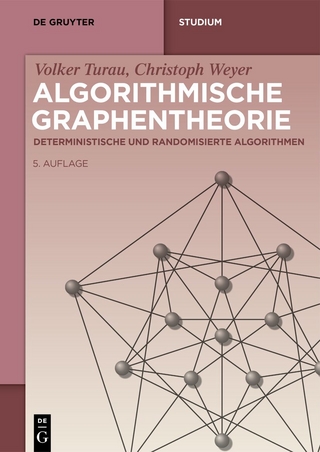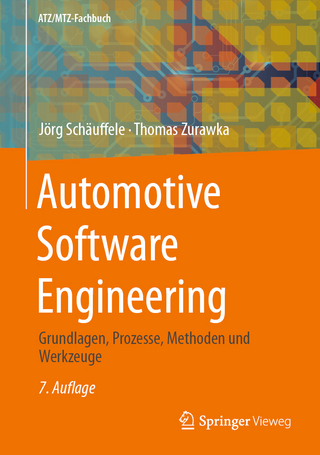
Software Architecture in Practice
Addison-Wesley Educational Publishers Inc (Verlag)
978-0-321-81573-6 (ISBN)
- Titel erscheint in neuer Auflage
- Artikel merken
The authors have structured this edition around the concept of architecture influence cycles. Each cycle shows how architecture influences, and is influenced by, a particular context in which architecture plays a critical role. Contexts include technical environment, the life cycle of a project, an organization’s business profile, and the architect’s professional practices. The authors also have greatly expanded their treatment of quality attributes, which remain central to their architecture philosophy—with an entire chapter devoted to each attribute—and broadened their treatment of architectural patterns.
If you design, develop, or manage large software systems (or plan to do so), you will find this book to be a valuable resource for getting up to speed on the state of the art.
Totally new material covers
Contexts of software architecture: technical, project, business, and professional
Architecture competence: what this means both for individuals and organizations
The origins of business goals and how this affects architecture
Architecturally significant requirements, and how to determine them
Architecture in the life cycle, including generate-and-test as a design philosophy; architecture conformance during implementation; architecture and testing; and architecture and agile development
Architecture and current technologies, such as the cloud, social networks, and end-user devices
Len Bass is a Senior Principal Researcher at National ICT Australia Ltd (NICTA). He joined NICTA in 2011 after twenty-five years at the Software Engineering Institute (SEI) at Carnegie Mellon University. He is the coauthor of two award-winning books in software architecture, including Documenting Software Architectures: Views and Beyond, Second Edition (Addison-Wesley, 2011), as well as several other books and numerous papers in computer science and software engineering on a wide range of topics. Len has almost fifty years’ experience in software development and research in multiple domains, such as scientific analysis systems, embedded systems, and information systems. Paul Clements is the Vice President of Customer Success at BigLever Software, Inc., where he works to spread the adoption of systems and software product line engineering. Prior to this position, he was Senior Member of the Technical Staff at the SEI, where, for 17 years, he lead or co-lead projects in software product line engineering and software architecture documentation and analysis. Other books Paul has coauthored include Documenting Software Architectures: Views and Beyond, Second Edition (Addison-Wesley, 2011) and Evaluating Software Architectures: Methods and Case Studies, (Addison-Wesley, 2002), and Software Product Lines: Practices and Patterns (Addison-Wesley, 2002). In addition, he has also published dozens of papers in software engineering reflecting his long-standing interest in the design and specification of challenging software systems. Paul was a founding member of the IFIP WG2.10 Working Group on Software Architecture. Rick Kazman is a Professor at the University of Hawaii and a Visiting Scientist (and former Senior Member of the Technical Staff) at the SEI. He is a coauthor of Evaluating Software Architectures: Methods and Case Studies, (Addison-Wesley, 2002). Rick’s primary research interests are software architecture, design and analysis tools, software visualization, and software engineering economics. He is also interested in human-computer interaction and information retrieval. Rick was one of the creators of several highly influential methods and tools for architecture analysis, including the SAAM (Software Architecture Analysis Method), the ATAM (Architecture Tradeoff Analysis Method), the CBAM (Cost-Benefit Analysis Method), and the Dali architecture reverse engineering tool.
Preface xv
Reader’s Guide xvii
Acknowledgments xix
Part One: Introduction 1
Chapter 1: What Is Software Architecture? 3
1.1 What Software Architecture Is and What It Isn’t 4
1.2 Architectural Structures and Views 9
1.3 Architectural Patterns 18
1.4 What Makes a “Good” Architecture? 19
1.5 Summary 21
1.6 For Further Reading 22
1.7 Discussion Questions 23
Chapter 2: Why Is Software Architecture Important? 25
2.1 Inhibiting or Enabling a System’s Quality Attributes 26
2.2 Reasoning About and Managing Change 27
2.3 Predicting System Qualities 28
2.4 Enhancing Communication among Stakeholders 29
2.5 Carrying Early Design Decisions 31
2.6 Defining Constraints on an Implementation 32
2.7 Influencing the Organizational Structure 33
2.8 Enabling Evolutionary Prototyping 33
2.9 Improving Cost and Schedule Estimates 34
2.10 Supplying a Transferable, Reusable Model 35
2.11 Allowing Incorporation of Independently Developed Components 35
2.12 Restricting the Vocabulary of Design Alternatives 36
2.13 Providing a Basis for Training 37
2.14 Summary 37
2.15 For Further Reading 38
2.16 Discussion Questions 38
Chapter 3: The Many Contexts of Software Architecture 39
3.1 Architecture in a Technical Context 40
3.2 Architecture in a Project Life-Cycle Context 44
3.3 Architecture in a Business Context 49
3.4 Architecture in a Professional Context 51
3.5 Stakeholders 52
3.6 How Is Architecture Influenced? 56
3.7 What Do Architectures Influence? 57
3.8 Summary 59
3.9 For Further Reading 59
3.10 Discussion Questions 60
Part Two: Quality Attributes 61
Chapter 4: Understanding Quality Attributes 63
4.1 Architecture and Requirements 64
4.2 Functionality 65
4.3 Quality Attribute Considerations 65
4.4 Specifying Quality Attribute Requirements 68
4.5 Achieving Quality Attributes through Tactics 70
4.6 Guiding Quality Design Decisions 72
4.7 Summary 76
4.8 For Further Reading 77
4.9 Discussion Questions 77
Chapter 5: Availability 79
5.1 Availability General Scenario 85
5.2 Tactics for Availability 87
5.3 A Design Checklist for Availability 96
5.4 Summary 98
5.5 For Further Reading 99
5.6 Discussion Questions 100
Chapter 6: Interoperability 103
6.1 Interoperability General Scenario 107
6.2 Tactics for Interoperability 110
6.3 A Design Checklist for Interoperability 114
6.4 Summary 115
6.5 For Further Reading 116
6.6 Discussion Questions 116
Chapter 7: Modifiability 117
7.1 Modifiability General Scenario 119
7.2 Tactics for Modifiability 121
7.3 A Design Checklist for Modifiability 125
7.4 Summary 128
7.5 For Further Reading 128
7.6 Discussion Questions 128
Chapter 8: Performance 131
8.1 Performance General Scenario 132
8.2 Tactics for Performance 135
8.3 A Design Checklist for Performance 142
8.4 Summary 145
8.5 For Further Reading 145
8.6 Discussion Questions 145
Chapter 9: Security 147
9.1 Security General Scenario 148
9.2 Tactics for Security 150
9.3 A Design Checklist for Security 154
9.4 Summary 156
9.5 For Further Reading 157
9.6 Discussion Questions 158
Chapter 10: Testability 159
10.1 Testability General Scenario 162
10.2 Tactics for Testability 164
10.3 A Design Checklist for Testability 169
10.4 Summary 172
10.5 For Further Reading 172
10.6 Discussion Questions 173
Chapter 11: Usability 175
11.1 Usability General Scenario 176
11.2 Tactics for Usability 177
11.3 A Design Checklist for Usability 181
11.4 Summary 183
11.5 For Further Reading 183
11.6 Discussion Questions 183
Chapter 12: Other Quality Attributes 185
12.1 Other Important Quality Attributes 185
12.2 Other Categories of Quality Attributes 189
12.3 Software Quality Attributes and System Quality Attributes 190
12.4 Using Standard Lists of Quality Attributes–or Not 193
12.5 Dealing with “X-ability”: Bringing a New Quality Attribute into the Fold 196
12.6 For Further Reading 200
12.7 Discussion Questions 201
Chapter 13: Architectural Tactics and Patterns 203
13.1 Architectural Patterns 204
13.2 Overview of the Patterns Catalog 205
13.3 Relationships between Tactics and Patterns 238
13.4 Using Tactics Together 242
13.5 Summary 247
13.6 For Further Reading 248
13.7 Discussion Questions 249
Chapter 14: Quality Attribute Modeling and Analysis 251
14.1 Modeling Architectures to Enable Quality Attribute Analysis 252
14.2 Quality Attribute Checklists 260
14.3 Thought Experiments and Back-of-the-Envelope Analysis 262
14.4 Experiments, Simulations, and Prototypes 264
14.5 Analysis at Different Stages of the Life Cycle 265
14.6 Summary 266
14.7 For Further Reading 267
14.8 Discussion Questions 269
Part Three: Architecture in the Life Cycle 271
Chapter 15: Architecture in Agile Projects 275
15.1 How Much Architecture? 277
15.2 Agility and Architecture Methods 281
15.3 A Brief Example of Agile Architecting 283
15.4 Guidelines for the Agile Architect 286
15.5 Summary 287
15.6 For Further Reading 288
15.7 Discussion Questions 289
Chapter 16: Architecture and Requirements 291
16.1 Gathering ASRs from Requirements Documents 292
16.2 Gathering ASRs by Interviewing Stakeholders 294
16.3 Gathering ASRs by Understanding the Business Goals 296
16.4 Capturing ASRs in a Utility Tree 304
16.5 Tying the Methods Together 308
16.6 Summary 308
16.7 For Further Reading 309
16.8 Discussion Questions 309
Chapter 17: Designing an Architecture 311
17.1 Design Strategy 311
17.2 The Attribute-Driven Design Method 316
17.3 The Steps of ADD 318
17.4 Summary 325
17.5 For Further Reading 325
17.6 Discussion Questions 326
Chapter 18: Documenting Software Architectures 327
18.1 Uses and Audiences for Architecture Documentation 328
18.2 Notations for Architecture Documentation 329
18.3 Views 331
18.4 Choosing the Views 341
18.5 Combining Views 343
18.6 Building the Documentation Package 345
18.7 Documenting Behavior 351
18.8 Architecture Documentation and Quality Attributes 354
18.9 Documenting Architectures That Change Faster Than You Can Document Them 355
18.10 Documenting Architecture in an Agile Development Project 356
18.11 Summary 359
18.12 For Further Reading 360
18.13 Discussion Questions 360
Chapter 19: Architecture, Implementation, and Testing 363
19.1 Architecture and Implementation 363
19.2 Architecture and Testing 370
19.3 Summary 376
19.4 For Further Reading 376
19.5 Discussion Questions 377
Chapter 20: Architecture Reconstruction and Conformance 379
20.1 Architecture Reconstruction Process 381
20.2 Raw View Extraction 382
20.3 Database Construction 386
20.4 View Fusion 388
20.5 Architecture Analysis: Finding Violations 389
20.6 Guidelines 392
20.7 Summary 393
20.8 For Further Reading 394
20.9 Discussion Questions 395
Chapter 21: Architecture Evaluation 397
21.1 Evaluation Factors 397
21.2 The Architecture Tradeoff Analysis Method 400
21.3 Lightweight Architecture Evaluation 415
21.4 Summary 417
21.5 For Further Reading 417
21.6 Discussion Questions 418
Chapter 22: Management and Governance 419
22.1 Planning 420
22.2 Organizing 422
22.3 Implementing 427
22.4 Measuring 429
22.5 Governance 430
22.6 Summary 432
22.7 For Further Reading 432
22.8 Discussion Questions 433
Part Four: Architecture and Business 435
Chapter 23: Economic Analysis of Architectures 437
23.1 Decision-Making Context 438
23.2 The Basis for the Economic Analyses 439
23.3 Putting Theory into Practice: The CBAM 442
23.4 Case Study: The NASA ECS Project 450
23.5 Summary 457
23.6 For Further Reading 458
23.7 Discussion Questions 458
Chapter 24: Architecture Competence 459
24.1 Competence of Individuals: Duties, Skills, and Knowledge of Architects 460
24.2 Competence of a Software Architecture Organization 467
24.3 Summary 475
24.4 For Further Reading 475
24.5 Discussion Questions 477
Chapter 25: Architecture and Software Product Lines 479
25.1 An Example of Product Line Variability 482
25.2 What Makes a Software Product Line Work? 483
25.3 Product Line Scope 486
25.4 The Quality Attribute of Variability 488
25.5 The Role of a Product Line Architecture 488
25.6 Variation Mechanisms 490
25.7 Evaluating a Product Line Architecture 493
25.8 Key Software Product Line Issues 494
25.9 Summary 497
25.10 For Further Reading 498
25.11 Discussion Questions 498
Part Five: The Brave New World 501
Chapter 26: Architecture in the Cloud 503
26.1 Basic Cloud Definitions 504
26.2 Service Models and Deployment Options 505
26.3 Economic Justification 506
26.4 Base Mechanisms 509
26.5 Sample Technologies 514
26.6 Architecting in a Cloud Environment 520
26.7 Summary 524
26.8 For Further Reading 524
26.9 Discussion Questions 525
Chapter 27: Architectures for the Edge 527
27.1 The Ecosystem of Edge-Dominant Systems 528
27.2 Changes to the Software Development Life Cycle 530
27.3 Implications for Architecture 531
27.4 Implications of the Metropolis Model 533
27.5 Summary 537
27.6 For Further Reading 538
27.7 Discussion Questions 538
Chapter 28: Epilogue 541
References 547
About the Authors 561
Index 563
| Erscheint lt. Verlag | 4.10.2012 |
|---|---|
| Reihe/Serie | SEI Series in Software Engineering |
| Verlagsort | New Jersey |
| Sprache | englisch |
| Maße | 157 x 239 mm |
| Gewicht | 1020 g |
| Themenwelt | Mathematik / Informatik ► Informatik ► Software Entwicklung |
| ISBN-10 | 0-321-81573-4 / 0321815734 |
| ISBN-13 | 978-0-321-81573-6 / 9780321815736 |
| Zustand | Neuware |
| Informationen gemäß Produktsicherheitsverordnung (GPSR) | |
| Haben Sie eine Frage zum Produkt? |
aus dem Bereich



